Environment: milieu / climate zone / depth range / distribution range
Ecología
marino; salobre asociado a arrecife; anfidromo (Ref. 51243); rango de profundidad 0 - 120 m (Ref. 30573). Tropical; 35°N - 20°S, 40°E - 156°E (Ref. 55462)
Indo-Pacific: probably throughout the warmer coastal waters, from the Red Sea and East Africa to the Solomon Islands, north to southern Japan, south to northern Australia. Recently reported from Tonga (Ref. 53797).
Tamaño / Peso / Age
Maturity: Lm ? range ? - ? cm
Max length : 100.0 cm SL macho / no sexado; (Ref. 188); 36.6 cm SL (female); common length : 60.0 cm TL macho / no sexado; (Ref. 5450)
Espinas dorsales (total) : 0; Radios blandos dorsales (total) : 16 - 19; Espinas anales: 0; Radios blandos anales: 29 - 36. Diagnosis: The slightly shorter pectoral fin, 11-13% of standard length, and the black marking of the upper part of the dorsal fin are the only satisfactory characters separating this species from Chirocentrus nudus; there is also some black on the anterior part of the anal fin (Ref. 188).
Occurs inshore, including brackish waters (Ref. 12743), from the shore to a depth of about 120 m (Ref. 30573). In Australia, it was reported in water temperatures of 26.0-29.0 °C (Ref. 4959). It feeds mainly on small fish and crustaceans (Ref. 188, 30573). Voracious predators of small schooling fishes, e.g. herrings and anchovies (Ref. 37816). Marketed fresh, frozen or dried and salted.
Life cycle and mating behavior
Madurez | Reproducción | Puesta | Huevos | Fecundidad | Larva
Whitehead, P.J.P., 1985. FAO Species Catalogue. Vol. 7. Clupeoid fishes of the world (suborder Clupeoidei). An annotated and illustrated catalogue of the herrings, sardines, pilchards, sprats, shads, anchovies and wolf-herrings. FAO Fish. Synop. 125(7/1):1-303. Rome: FAO. (Ref. 188)
IUCN Red List Status (Ref. 130435: Version 2024-1)
Threat to humans
Harmless
Human uses
Pesquerías: comercial; pesca deportiva: si; carnada: usually
Herramientas
Special reports
Download XML
Fuentes de Internet
Estimates based on models
Preferred temperature (Ref.
123201): 25.5 - 29.1, mean 28.1 °C (based on 1980 cells).
Phylogenetic diversity index (Ref.
82804): PD
50 = 1.0000 [Uniqueness, from 0.5 = low to 2.0 = high].
Bayesian length-weight: a=0.00513 (0.00361 - 0.00729), b=2.96 (2.86 - 3.06), in cm total length, based on LWR estimates for this species (Ref.
93245).
Nivel trófico (Ref.
69278): 4.4 ±0.89 se; based on food items.
Resiliencia (Ref.
120179): Medio, población duplicada en un tiempo mínimo de 1.4-4.4 años (Assuming tm=2).
Prior r = 0.54, 95% CL = 0.36 - 0.81, Based on 9 data-limited stock assessments.
Fishing Vulnerability (Ref.
59153): High to very high vulnerability (73 of 100).
Climate Vulnerability (Ref.
125649): High to very high vulnerability (75 of 100).
Nutrients (Ref.
124155): Calcium = 24.9 [13.8, 49.1] mg/100g; Iron = 0.471 [0.261, 0.831] mg/100g; Protein = 20.3 [17.7, 22.5] %; Omega3 = 0.138 [0.072, 0.264] g/100g; Selenium = 51.3 [26.6, 110.1] μg/100g; VitaminA = 67.5 [19.3, 202.7] μg/100g; Zinc = 0.827 [0.566, 1.249] mg/100g (wet weight); based on
nutrient studies.
